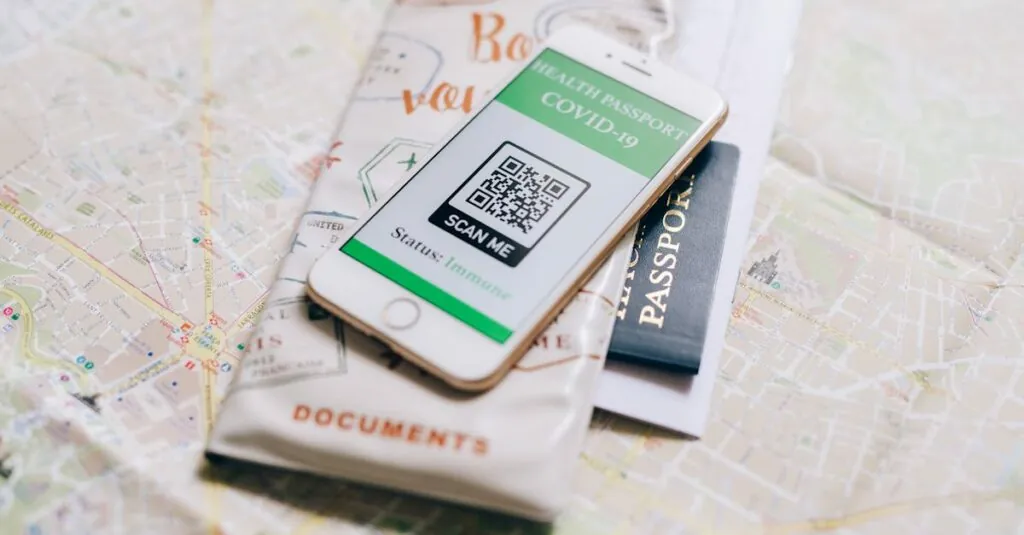Table of Contents
ToggleIn a world where everything seems to be just a scan away, QR codes have become the unsung heroes of convenience. Whether it’s unlocking a menu at your favorite restaurant or accessing exclusive deals, these little squares pack a punch. But let’s face it: if you’ve ever stared at a QR code like it’s an alien artifact, you’re not alone.
Understanding QR Codes
QR codes, short for Quick Response codes, are two-dimensional barcodes that store various types of information. They often appear as square-shaped patterns, consisting of black squares arranged on a white grid. Businesses and organizations utilize QR codes for several purposes, including marketing, product tracking, and payment processing.
Scanning a QR code can provide immediate access to websites, videos, or other digital content, making them versatile tools in a tech-driven world. Statistics show that 11 million U.S. households scanned a QR code in 2020, reflecting their growing popularity. This trend has only increased, with many people using smartphones for contactless transactions and information retrieval.
Creating a QR code involves generating a unique code that reflects a specific URL or data. Various online generators are available, allowing users to customize their codes with colors and logos. Such codes encourage engagement, making it easy for users to connect without manual entry.
Smartphones, particularly iPhones, simplify the scanning process. The built-in camera recognizes QR codes without needing additional apps. Core functionality allows users to point their camera at a QR code, leading to immediate access to the stored information.
Safety concerns surround QR codes as well. Scammers can exploit them, directing users to malicious websites. Users must verify source credibility before accessing any content through a scanned code, ensuring their information remains secure.
Scanning QR Codes with Your iPhone
Scanning QR codes on an iPhone is straightforward and convenient. Users can either employ the built-in camera or utilize a dedicated QR code scanner app for quick access.
Using the Camera App
The camera app on iPhones easily scans QR codes without any additional downloads. Users must simply open the camera and point it at the code. When the code appears in focus, a notification pops up, displaying the linked content. Tapping this notification leads to the relevant website or app. This method works with various iPhone models, ensuring a seamless scanning experience. Engaging with QR codes through the camera app simplifies tasks like accessing menus or making payments on the go.
Using a QR Code Scanner App
For those seeking enhanced features, QR code scanner apps are available in the App Store. These apps offer options to save scanned codes, organize them, and share them easily. Users can download a scanner app, follow the setup instructions, and open the app. A simple scan captures the code and reveals the associated information. Some apps provide history logs, making it easier to return to previously scanned codes. These specialized tools cater to users wanting more functionality, such as creating their own QR codes.
Troubleshooting QR Code Scanning Issues
Scanning QR codes can sometimes present challenges. Knowing how to address common problems enhances the overall experience.
Common Problems and Solutions
One frequent issue is the camera not recognizing the code. Ensuring the code is well-lit and within focus can facilitate better recognition. Another problem involves the scanner not responding. Testing another QR code can determine if the initial code is faulty. Additionally, software glitches may hinder scanning. Restarting the camera app or rebooting the iPhone often resolves this issue. Occasionally, outdated software impacts scanning performance. Keeping the iPhone updated to the latest version guarantees optimal functionality.
Tips for Successful Scanning
Positioning the QR code within the camera’s frame optimizes scanning success. Adjusting the distance between the code and the camera helps achieve clear visibility. Moving to different lighting conditions can improve scanning chances if initial attempts fail. Users should ensure the QR code is free from obstruction or damage. Clearing the camera lens from smudges or dirt promotes clarity. Finally, testing with various QR codes leads to a better understanding of the scanner’s capabilities.
Alternative Methods to Access QR Codes
Users can explore diverse approaches for accessing QR codes beyond the built-in camera. One notable option involves using mobile wallets, such as Apple Wallet. Many services allow users to add QR codes directly to their wallets. This method enables quick access anytime without needing a separate scanning app.
Website and app integrations often feature built-in QR code scanning capabilities. Some popular applications, like social media platforms, offer their own QR scanners. Within these apps, users can either scan or generate QR codes for sharing profiles or content easily.
Third-party camera apps present additional scanning solutions. These apps often enhance scanning capabilities with features like auto-focus and history tracking. Users might find more control and utility with these apps, especially in low-light situations or when scanning smaller codes.
Physical QR code scanners also exist for environments like retail and events. Dedicated devices read QR codes quickly, providing convenience in high-traffic areas. Organizations may benefit from these options to streamline processes involving multiple QR codes.
In addition to manual scanning methods, screenshotting QR codes is another alternative. Some iPhone users can capture the code displayed on their screen and later scan it from their photo library using specific apps. This method proves useful for saving codes encountered in digital communications or print media.
Finally, users can leverage browser extensions and plugins, especially on desktop devices. Various extensions allow for scanning QR codes directly from a web page, enhancing efficiency during online activities. Integrating these methods can elevate the QR code scanning experience, offering flexibility and accessibility across multiple platforms.
Scanning QR codes with an iPhone is a straightforward process that opens up a world of convenience. By utilizing the built-in camera or dedicated apps users can quickly access information and services with just a few taps.
As QR codes continue to gain popularity it’s essential to stay informed about the best practices for scanning and ensuring safety while accessing linked content. With the variety of methods available users can choose the approach that best fits their needs. Embracing this technology not only enhances everyday tasks but also keeps users connected in an increasingly digital world.




